Cover design

Vol. 81, 2, 2024: In this issue of AJBM, Ferrer-Gallego presents the lectotypification of four Linnaean names in the genus Euphorbia: E. exigua, E. exigua var. acuta, E. paralias, and E. segetalis. The cover features a field image of Euphorbia segetalis (photo Joan Simon)..
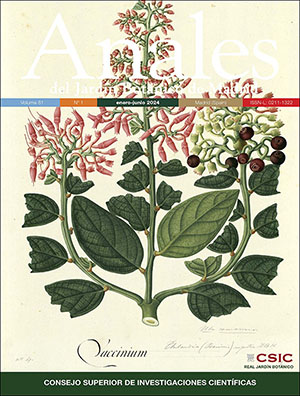
Vol. 81, 1, 2024: In this issue of AJBM, Luteyn & Pedraza-Peñalosa present nomenclatural updates based on a detailed revision of the specimens of Ericaceae collected by José Cuatrecas during his first visit to Colombia. The cover features an illustration of Macleania rupestris an Ericaceae from Colombia included in the study [AJB, DIV. III A-1829, en Fl. Real Exped. Bot. Nuevo Reino Granada, 21: tab. 27. 2015].
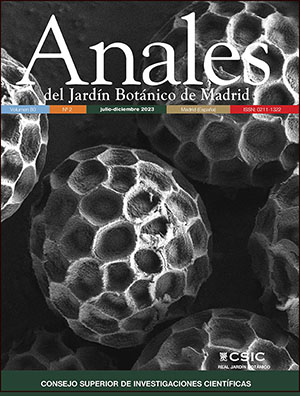
Vol. 80, 2, 2023: In this issue of AJBM, Denchev & al. report new records of smut fungi from Russia, Greece and Morocco. The cover features a scanning electron microscopy (SEM) image of spores of Microbotryum moehringiae on Moehringia trinervia from Morocco (Photo: T.T. Denchev).
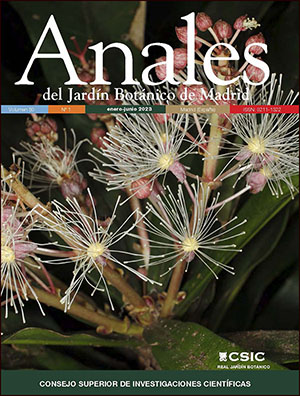
Vol. 80, 1, 2023: In this issue of AJBM, Velayos & al. provide a cheklist of the vascular plants of Río Muni (Equatorial Guinea) including a floristic analysis, data on endemicity and threatened status. The cover image shows Pycnocoma macrophylla Benth (Euphorbiaceae), a species native to the Guineo Congolian region in tropical Africa (Photo: M. Velayos)..
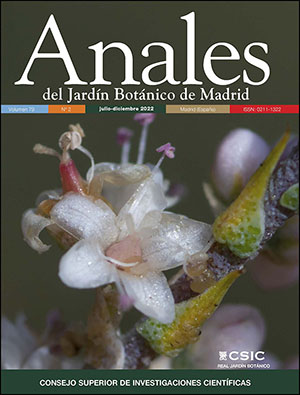
Vol. 79, 2, 2022: In this issue of AJBM, Villar & al. present a taxonomic revision of the genus Tamarix for the Iberian Peninsula and Balearic Islands. The cover image shows a flower from an inflorescence of Tamarix gallica L. (Photo: J.L. Villar).
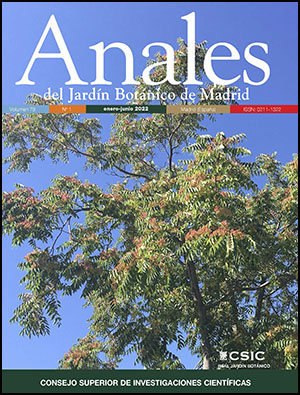
Vol. 79, 1, 2022: In this issue of AJBM, Bayón & al. evaluate the invasion risk of non-native trees in urban parks across Spain. The cover image shows an individual of Ailanthus altissima (Miller) Swingle., a highly invasive species cultivated in urban parks.
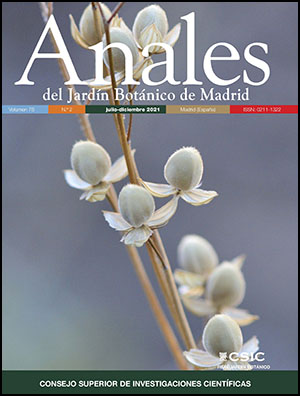
Vol. 78, 2, 2021: In this issue of AJBM, Martín-Hernanz & al. propose systematic changes in the genus Helianthemum based on phylogenetic evidence. The cover image shows the fruits of Helianthemum juliae Wildpret. from the Cañadas del Teide, Tenerife (Photo: R.G. Albadalejo).
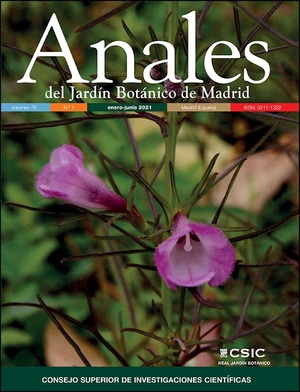
Vol. 78, 1, 2021: In this issue of AJBM, Venugopal & al. present a new species of Parasopubia (Orobanchaceae) from India. The cover photo shows the flowers of Parasopubia raghavendrae Divya & Nampy sp. nov. (Photo: S.R. Sasi).
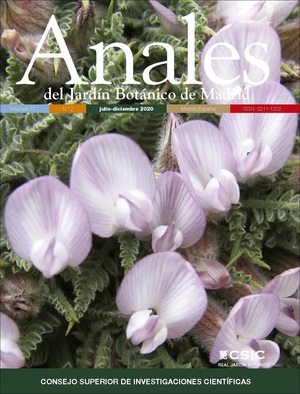
Vol. 77, 2, 2020: In this issue of AJBM, A.H. Pahlevani, A.A. Maassoumi, and S. Kazempour-Osaloo present a new Iranian alpine species of Astragalus sect. Anthylloidei. Here the flowers of Astragalus wiesneri sp. nov. (Photo: A.H. Pahlevani).
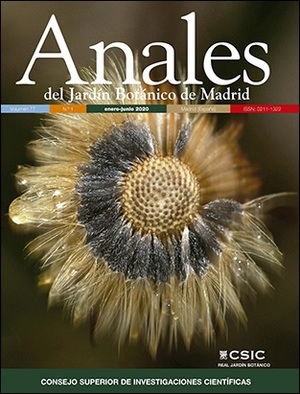
Vol. 77, 1, 2020: In this issue of AJBM, I. Arnelas, J.L. Armijos-Barros and J. Calvo present a taxonomic study of the genus Oritrophium (Astereae, Compositae) in Ecuador. The cover photo shows the achenes of O. tergoalbum (Cuatrec.) Cuatrec. (Photo: I. Arnelas).
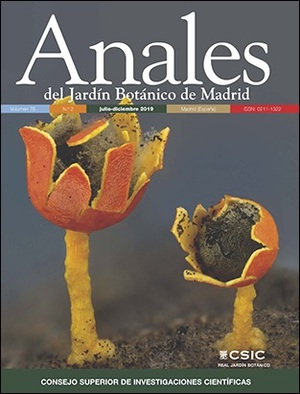
Vol. 76, 2, 2019: In this issue of AJBM, C. Lado, D. Wrigley de Basanta, A. Estrada-Torres, S.L. Stephenson and I. Treviño describe the diversity of Myxomycetes in arid zones of Peru. Here dehisced sporocarps of Diderma miniatum Nann.-Bremek (Myxomycetes). (Photo: Carlos de Mier).
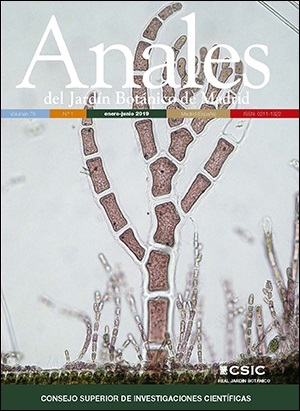
Vol. 76, 1, 2019: In this issue of AJBM, V. García-Redondo, I. Bárbara and P. Díaz-Tapia describe the biodiversity of epiphytic macroalgae on leaves of Zostera marina. Here juvenile thallus of Aglathamnion hookeri with Colaconema daviesii at the base. (Photo: V. García-Redondo).
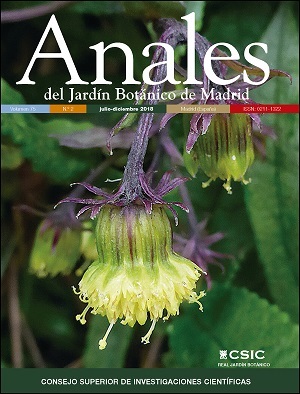
Vol. 75, 2, 2018: In this issue of AJBM Antoni Buira, Carlos A. Velasco and Joel Calvo cite for the first time Senecio subinvolucratus Cuatrec. in Colombia. (Photo: Joel Calvo).
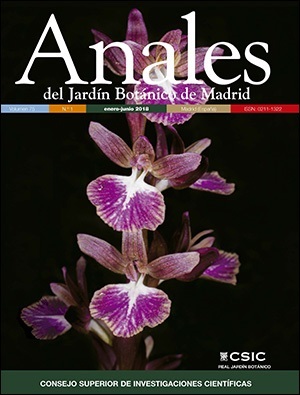
Vol. 75, 1, 2018: In this issue of AJBM Lluis Serra and José Antonio López describe Anacamptis × dafnii nothosubsp. solanoi Serra & López Esp., a new hybrid of Orchidaceae from Spain. (Photo: Lluis Serra Laliga).
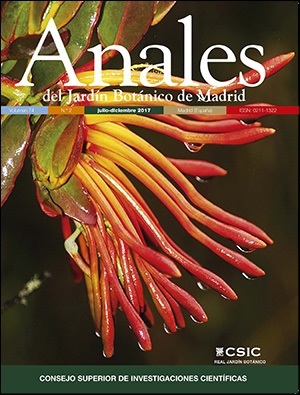
Vol. 74, 2, 2017: Floral diversification in Loranthaceae reaches its highest peak in the Andes. Tristerix secundus (Benth.) Kuijt is one of the Colombian species studied by Favio González and Natalia Pabón-Mora in this issue of AJBM. (Photo: Sebastían González)
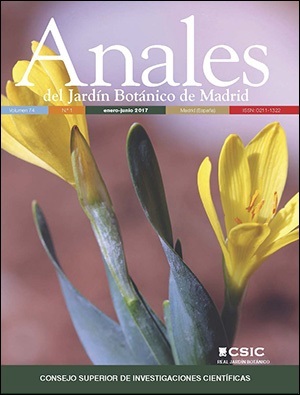
Vol. 74, 1, 2017: Sternbergia vernalis (Mill.) Gorer & J.H. Harvey (Amaryllidaceae) has been found in the mountains of Berwarya, after being considered a lost species in Iraq during the last 80 years. This is part of the contributions that Sami Youssef, Ahmed Mahmood and Errol Vela present in this issue of AJBM. (Photo: Sami Youssef).
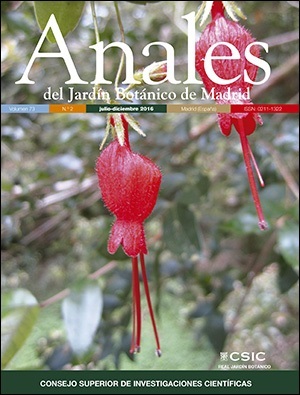
Vol. 73, 2, 2016: Sarmienta scandens (Molina ex J.D. Brandis) Pers. (Gesneriaceae), an epifite endemic from the austral forests of Chile, is one of the representative species of the vascular flora of San Ignacio de Huinay (Chile) that Ramón Morales, José Luis Fernández Alonso, Reinhard Fitzek, Leopoldo Medina & Félix Muñoz Garmendia, presents in this issue of AJBM. (Photograph: Ramón Morales).
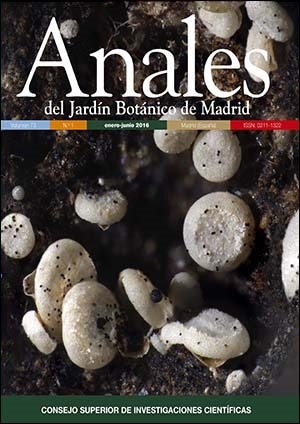
Vol. 73, 1, 2016: Didymium peruvianum Lado, D. Wrigley & S.L. Stephenson (described in this issue of AJBM) is a new species of myxomycete found in arid zones of Peru, from sea level to almost 4000 m. This microorganism, of less than 0,5 mm of diameter, present discoid fruiting bodies, protected by a characteristic calcareous layer. The new species is an example of the hidden diversity in deserts. (Photograph: Carlos de Mier).
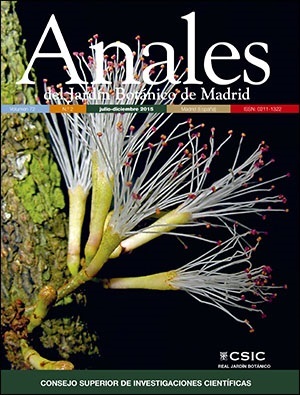
Vol. 72, 2, 2015: Zygia cognata (Schltdl.) Britton & Rose (Leguminosae), known in Mexico, Guatemala and Belize. In the Mexican portion of the Yucatan Peninsula there are three species of Zygia. José Enrique López-Contreras, Maria de Lourdes Rico-Arce, Lilia Lorena Can-Itza & Rodrigo Duno de Stefano in the present issue of AJBM, discusses morphological differences and nomenclature of the three species. (Photograph: Germán Fernández- Concha).
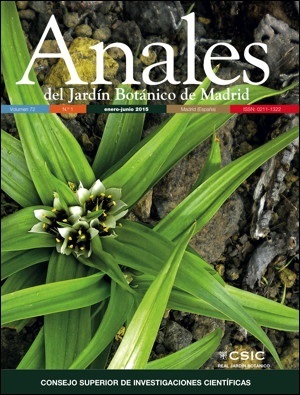
Vol. 72, 1, 2015: Androcymbium hierrense A. Santos (Colchicaceae), a Canarian endemic species. The scarce knowledge on the distribution of the natural populations in the island of La Palma, hampers the identification of priorities for undertaking actions for its conservation. Félix Manuel Medina & Raul Fernández de León in the present issue of AJBM, present a survey in which, the species is distributed in 14 locations grouped into two differentiated areas. (Photograph: Félix Manuel Medina).

Vol. 71, 2, 2014: Flowers of Ophrys tenthredinifera Willd. (Orchidaceae). Species distributed all over the Mediterranean Región and the Canary Islands. In the present issue of AJBM, Pablo Galán Cela & al. have studied the micromorphology of the seeds of this taxon and other 18 of the genus Ophrys, using SEM and light microscope. (Photograph: Pablo Galán Cela).
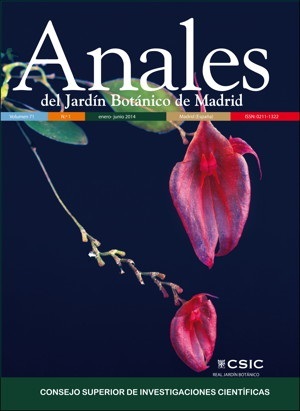
Vol. 71, 1, 2014: Lepanthes ruberrima Pupulin is one of the Costa Rica orchid species member of the L. guatemalensis complex. Pupulin and Bogarín publish in this issue of AJBM the taxonomy of this group for central America, including the description of some new taxa. (Photograph: F. Pupulin).
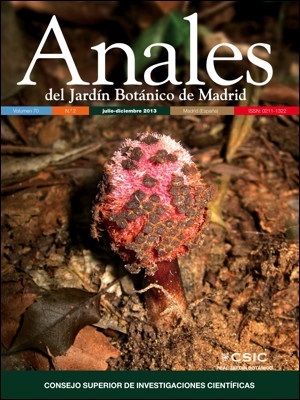
Vol. 70, 2, 2013: Inflorescence of Helosis cayennensis var. cayennensis (Sw.) Spreng., a parasitic species distributed acroos rain forests form the neotropical region. The species belongs to a monotypic genus from the family Balanophoraceae and its unusual development and structure of the staminate flower are studied by Ana María González & al. in the present issue of AJBM. (Photograph: Ana M. González & Orlando F. Popoff ).
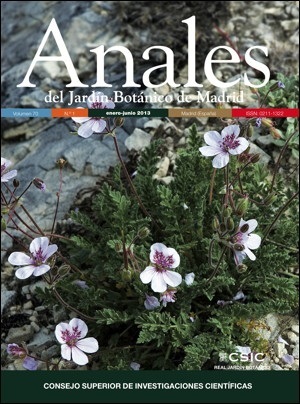
Vol. 70, 1, 2013: Erodium cazorlanum Heywood (Geraniaceae) is a small woody chamaephyte, endemic to southeastern Iberian Peninsula where it grows in a few dolomite outcrops in the Baetic Ranges. In this number of AJBM, Alonso & García-Sevilla demonstrate, under controlled conditions, individual variability in the relative success of self and cross hand-pollinations, and a strong inbreeding depression. (Photograph: Carlos M. Herrera).
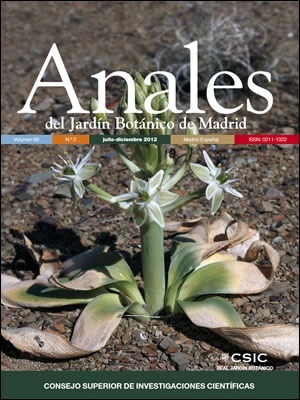
Vol. 69, 2, 2012: Ethesia is a small genus from the family Hyacinthaceae (subfam. Ornithogaloideae) endemic to Namibia and South Africa. In this AJBM issue, Martínez-Azorín & Crespo describe the new species Ethesia tanquana, a showy geophyte, th










